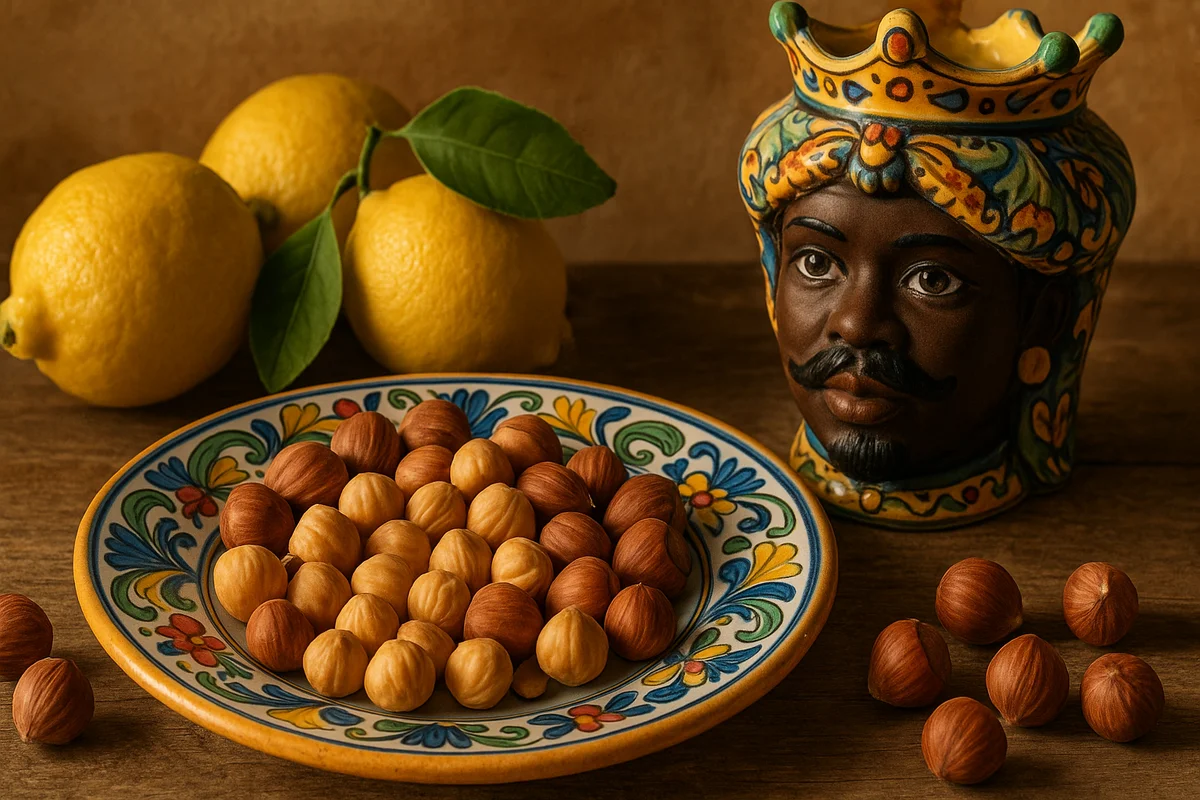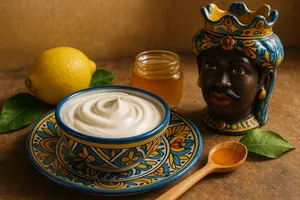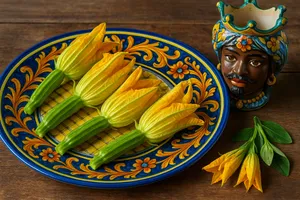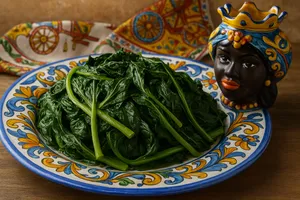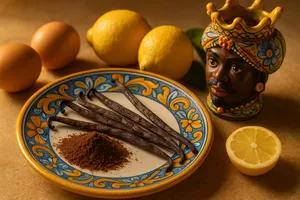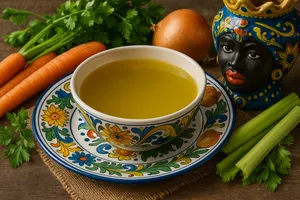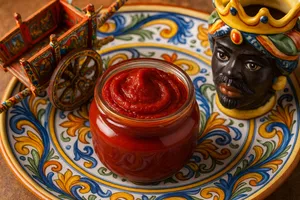Overview
Hazelnuts, known in Sicilian as “nuciddi”, are the fruits of the hazel tree (Corylus avellana), a shrub or small tree that thrives in Sicily’s hilly and mountainous regions, particularly on the Nebrodi, the Madonie and Mount Etna. These oily seeds, enclosed in a hard wooden shell, have been valued for millennia for their sweet, rich flavour, crisp texture and broad nutritional properties. Although Sicily is not among Italy’s leading hazelnut producers (a title held by Piedmont), Sicilian hazelnuts—especially local varieties—possess excellent organoleptic qualities and are highly appreciated.
In Sicilian tradition, hazelnuts were a precious resource, gathered in autumn and stored for the winter. They grew wild in woodland as well as in small family plots. Freshly harvested hazelnuts made a delicious snack, while dried hazelnuts featured in numerous traditional sweets: torrone, brittle, biscuits, almond pastries enriched with hazelnuts, and Christmas nougats. Beyond pastry-making, hazelnuts were toasted and eaten as snacks, or chopped and used to enhance fillings and savoury dishes. Today, Sicilian patisserie continues to employ hazelnuts abundantly, prized for their flavour, which pairs beautifully with chocolate, honey and other sweet ingredients.
Characteristics
Hazelnuts appear as oval or rounded seeds, measuring between 1 and 2.5 centimetres, enclosed within a hard, light brown wooden shell. The edible kernel is covered by a thin, light brown or reddish skin that is slightly astringent.
The kernel is cream-white, firm and crisp when fresh or roasted, softer when stored for a long time. Its flavour is sweet, rich and buttery, with characteristic notes of wood and dried fruit. The aroma is intense and fragrant, especially after roasting.
Quality hazelnuts have intact shells without cracks or holes (a sign of pests), are heavy for their size (very light nuts may be dry or empty), and have kernels that are firm, crisp and uniformly cream-coloured, without spots or rancid odours.
Varieties
Many varieties of hazelnuts exist, differing in shape, size, flavour and yield. Italy’s principal varieties are Piedmontese (the prized Tonda Gentile delle Langhe), as well as Lazio and Campania types. Sicily grows local varieties adapted to the Mediterranean climate.
Sicilian hazelnut
Local varieties traditionally cultivated in Sicily, often not formally classified but handed down within families. They are medium-small in size, with intense, aromatic flavour and good oil content. They adapt well to Sicilian conditions and small-scale cultivation.
Wild hazelnuts
Those growing spontaneously in Sicilian woodland, especially in mountain areas. Smaller than cultivated types but very flavourful. Harvesting is labour-intensive due to their size, yet the result is highly valued.
Modern cultivated varieties
Newer plantations employ selected commercial varieties aimed at productivity and quality: Tonda di Giffoni, Tonda Gentile Romana and other high-yield types.
Cultivation in Sicily
In Sicily, hazel trees thrive in hilly and mountainous zones, favouring altitudes between 400 and 900 metres, mild climates with good rainfall, and fertile, well-drained soils. Main growing areas include the Nebrodi, the Madonie, Etna and the Hyblaean Mountains.
The hazel is a hardy plant that grows as a shrub or small tree. It produces shoots from the base, forming dense clumps. Flowering occurs in winter (January–March), with conspicuous yellow catkins appearing before the leaves. Pollination is by wind.
Fruits ripen in late summer to autumn (August–October). Traditional harvesting involved striking the branches with sticks to make the ripe nuts fall, then gathering them from the ground. Modern operations use mechanical shakers and harvesters.
After harvesting, hazelnuts are dried in the sun or in dryers to reduce moisture and ensure preservation. The shell protects the kernel, allowing it to keep for months.
Use in Sicilian pastry-making
Hazelnuts are a fundamental ingredient in Sicilian confectionery.
Torrone and brittle
Sicilian torrone uses whole or chopped toasted hazelnuts, often alongside almonds, bound with honey or caramelised sugar. Hazelnut brittle is similar—hazelnuts embedded in thin sheets of caramelised sugar.
Hazelnut paste
Finely ground, toasted hazelnuts become a fragrant, oily paste used to fill pastries, prepare creams and enrich gelato. Similar to almond paste but with a more intense, buttery flavour.
Biscuits
Many Sicilian biscuits incorporate hazelnuts—chopped in the dough, whole as decoration or milled into hazelnut flour. Hazelnut biscuits have a rich flavour and delicate crumb.
Hazelnut gelato
A classic of Sicilian gelaterie. Prepared with toasted hazelnut paste, it has a light brown colour and intense flavour. It is among the most beloved flavours, often paired with chocolate.
Hazelnut granita
A less common but highly appreciated speciality, hazelnut granita is made with hazelnut paste, milk and sugar. Its texture is creamy and its flavour full and rich.
Christmas nougats
At Christmas, hazelnuts feature in numerous traditional sweets: mustazzoli, nucatoli, buccellati (in the filling with dried figs and almonds), and cubbaita (sesame and hazelnut brittle).
Chocolate and hazelnuts
The chocolate–hazelnut pairing is a classic. In Sicily, Modica chocolate is often enriched with hazelnut granules, and there are pralines and filled chocolates made with hazelnut cream.
Other culinary uses
Beyond patisserie, hazelnuts serve in many other preparations.
Pesto and dressings
Chopped hazelnuts enrich pesto and dressings for pasta. A hazelnut pesto with basil, garlic, oil and cheese offers an appealing variation on the classic Genovese sauce.
Fillings
Chopped hazelnuts appear in fillings for meat (rolls, stuffed roasts), stuffed vegetables and savoury dishes, adding texture and flavour.
Salads
Toasted, broken hazelnuts enhance mixed salads with crunch and aroma. They pair well with cheeses, fruit and bitter greens.
Hazelnut oil
Oil extracted by cold pressing is prized for its intense hazelnut flavour. Used raw to dress salads, vegetables or to scent sweets, it is a gourmet ingredient with a high price.
Snacks
Toasted hazelnuts, salted or plain, are a satisfying, nutritious snack—eaten alone or mixed with other nuts.
Preparation
Freshly gathered hazelnuts must be dried to ensure storage. They are spread in the sun or dried in warm-air dryers for several days until the shell separates easily from the kernel and the interior is dry.
Hazelnuts are cracked with a nutcracker or specific tools. For large quantities, mechanical shellers are used.
To remove the skin (common in pastry-making), hazelnuts are roasted in the oven at 150–180°C for 10–15 minutes, until the skins loosen. Once slightly cooled, they are rubbed between the hands or in a cloth to shed the skins. Some skins remain—this is normal.
For chopping or grinding, a knife works for coarse pieces; a food processor or grinder for finer textures; a coffee grinder for hazelnut flour. Over-grinding produces an oily paste (ideal if hazelnut paste is desired).
Roasting
Roasting enhances the flavour of hazelnuts, intensifying aroma and adding toasted, caramel-like notes. They are roasted in the oven at 150–180°C for 10–15 minutes, stirring halfway, or in a pan over medium heat for 5–10 minutes, stirring constantly.
Hazelnuts are perfectly roasted when golden, highly fragrant and when the skin detaches easily. They should be removed from the oven before darkening too much, as they continue cooking with residual heat.
Roasted hazelnuts keep well in airtight containers and are ideal for both sweet and savoury preparations requiring a toasted note.
Storage
Hazelnuts in the shell keep for 6–12 months in cool, dry, dark places, stored in jute sacks or ventilated containers. The shell protects them from oxidation and rancidity.
Shelled hazelnuts keep for 2–3 months in airtight containers in cool, dark conditions. In the refrigerator they last 4–6 months, and in the freezer over a year. Shelled nuts turn rancid more quickly due to their high oil content.
Chopped or ground hazelnuts keep for shorter periods (1–2 months) because their exposed surface area speeds oxidation. Refrigeration or freezing improves shelf life.
Rancid hazelnuts taste and smell unpleasantly bitter and must be discarded.
Shopping tips
When buying hazelnuts in the shell, ensure the shell is intact, without cracks or holes, clean and uniformly brown. When shaken, the kernel should not rattle inside (a sign of dryness or emptiness).
Shelled hazelnuts should be cream-white or light brown, uniformly coloured, firm and crisp, with a pleasant aroma of fresh hazelnut and no rancid or mouldy odours.
Always check packing or expiry dates. Prefer Italian hazelnuts—ideally Sicilian or Piedmontese (the exceptional Tonda Gentile delle Langhe PDO). For pastry-making, ready-to-use toasted, skinned hazelnuts are convenient but more expensive.
Buy from reliable suppliers who ensure correct storage. Poorly stored hazelnuts may develop toxic moulds (aflatoxins).
Nutritional properties
Hazelnuts are highly caloric and nutritious: 100 grams provide about 630–650 calories. They contain around 60% fat, mostly unsaturated (beneficial for cardiovascular health), roughly 15% protein, 10–12% carbohydrates, 10% fibre and 5% water.
They are rich in vitamin E (a powerful antioxidant), B vitamins (especially B1, B6 and folate) and vitamin K. They contain important minerals: magnesium, potassium, calcium, phosphorus, iron, zinc, copper and manganese.
Thanks to vitamin E and polyphenols, hazelnuts have notable antioxidant properties. Their unsaturated fats help reduce LDL (“bad”) cholesterol and increase HDL (“good”) cholesterol. Fibre aids digestion and satiety.
They are an excellent energy source for athletes, students and those engaged in demanding physical work. Due to their high calorie content, moderate consumption is recommended: 20–30 grams per day (about 15–20 hazelnuts) is reasonable.
Allergies
Hazelnuts are among the most common allergens. Hazelnut allergy can cause reactions ranging from mild (itching, hives) to severe (anaphylactic shock). Those allergic must avoid hazelnuts and all products containing them. Labels should be checked carefully, as hazelnuts appear in many industrial foods (chocolate, biscuits, spreads, ice creams).
Hazelnut allergy is often associated with allergies to other nuts (almonds, walnuts) and birch pollen (cross-reactivity).
Curiosities
Hazelnuts are among the oldest fruits consumed by humans. Archaeological remains show they were gathered and eaten as early as the Paleolithic, over 10,000 years ago. For millennia they were an essential food source for European populations.
In Greek and Roman mythology, the hazel tree was considered magical. Hazel branches were believed to have divinatory and protective powers. In Sicily, popular beliefs attributed to the hazel the ability to ward off evil spirits and lightning.
A Sicilian saying goes: “Cu' havi nuciddi 'n sacchetta, 'un mori di fami” (Whoever has hazelnuts in their pocket will not starve), highlighting their nutritional value and portability.
The famous Italian chocolate–hazelnut spread was invented in Piedmont after the Second World War, when cocoa was rationed. To stretch the limited chocolate supply, generous quantities of Piedmontese hazelnuts were added, creating a product that became a worldwide success. Sicily produces artisanal variations using local hazelnuts.
Hazelnuts were symbols of wisdom and fertility. In some rural Sicilian areas, hazelnuts were given to newlyweds as a wish for prosperity and abundance.
During traditional hazelnut harvesting, Sicilian farming families gathered to strike branches and collect the fallen nuts. It was a social event filled with songs and stories, strengthening community bonds. Children participated enthusiastically, and at day’s end the harvest was shared fairly.
Hazel wood, flexible and sturdy, was used to craft walking sticks, tool handles, sieve rims and plant supports. Young branches were woven into baskets and containers.
In some mountainous parts of Sicily, wild hazelnuts gathered in woodland were considered finer than cultivated varieties due to their intense flavour. Skilled foragers knew the best shrubs and kept their favourite spots secret.

